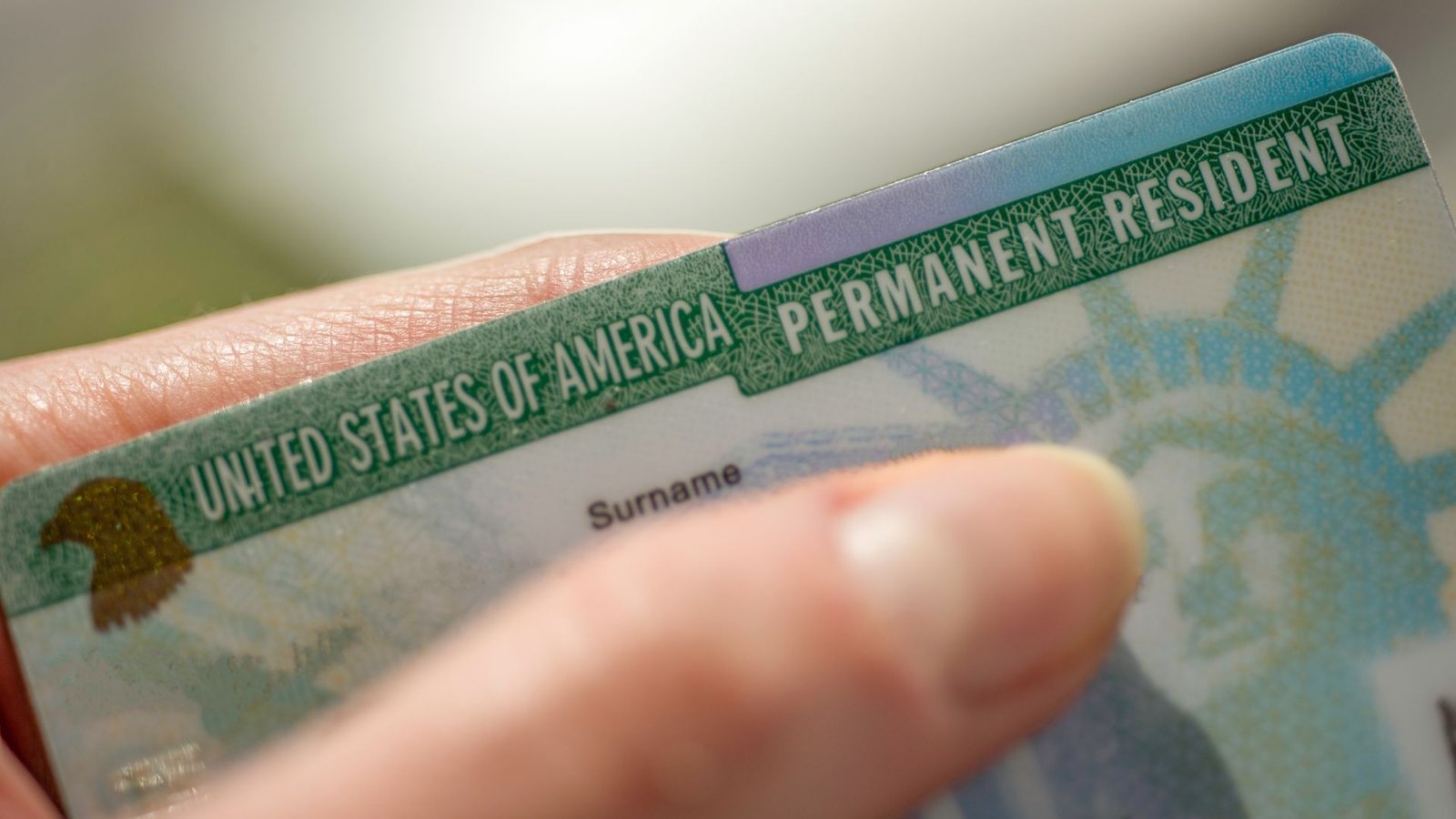On this page you will read detailed information about Green Card Eligibility.
As an immigrant seeking lawful permanent residence in the United States, you may be wondering if you qualify for a green card and how to navigate the application process. With over one million green cards issued annually, determining your eligibility is the critical first step. In this article, you will learn the different paths to qualifying for permanent residency, from family-sponsored to employment-based applications. The step-by-step guide outlines everything you need to know to successfully complete your green card application, including required forms and documents, processing times and fees. Gain valuable insight into this complex process so you can pursue permanent U.S. residence confidently.
What Is a Green Card?

A green card, also known as a permanent resident card, is an identification document issued by U.S. Citizenship and Immigration Services (USCIS) that proves you have permanent resident status in the United States. As a green card holder, you have the right to live and work permanently in the U.S., apply for U.S. citizenship if you meet certain eligibility criteria, and receive benefits like Social Security and Medicare.
Permanent Resident Status
Permanent resident status allows you to live and work in the U.S. indefinitely. However, it is not the same as U.S. citizenship. As a permanent resident, you must renew your green card every 10 years and you can lose your status if you move out of the U.S., commit certain crimes, or are found to be inadmissible or deportable under U.S. immigration law. To become a naturalized U.S. citizen, you must meet the eligibility criteria, including living in the U.S. as a permanent resident for at least 5 years.
Applying for a Green Card
There are several paths to obtaining a green card, including through family sponsorship, employment, humanitarian programs, or the diversity visa lottery. The process typically involves filing a visa petition, application forms, documents proving your eligibility, and an interview. The time it takes to get a green card depends on the category under which you are applying and processing times, which can vary. Once your application is approved, your green card will be mailed to you.
In summary, a green card provides permanent resident status allowing you to live and work in the U.S. long-term. While it does not make you a citizen, as a green card holder you have the opportunity to naturalize after meeting certain requirements. The process of obtaining a green card will differ depending on your individual situation and the category under which you are eligible.
Green Card Eligibility: Who Qualifies?
Family-Based Green Cards
If you have a family member who is a U.S. citizen or lawful permanent resident (green card holder), they may be able to sponsor you for a family-based green card. The categories include:
- Immediate relatives (spouses, unmarried children under 21, and parents of U.S. citizens over 21)
- Unmarried sons and daughters of U.S. citizens
- Married sons and daughters of U.S. citizens
- Brothers and sisters of U.S. citizens over 21
- Spouses and unmarried children of lawful permanent residents
The process involves filing a family-based visa petition, application forms, and supporting documents. The wait time depends on the category and country of origin.
Employment-Based Green Cards
If you have a job offer from a U.S. employer, you may be eligible for an employment-based green card. The categories include:
- EB-1: Priority workers (extraordinary ability, outstanding professors/researchers, multinational executives/managers)
- EB-2: Professionals with advanced degrees or exceptional ability
- EB-3: Skilled or professional workers, unskilled workers
- EB-4: Special immigrants (religious workers, employees of U.S. foreign service posts)
- EB-5: Immigrant investors
The employer files a labor certification and I-140 immigrant petition to establish that there are no qualified U.S. workers for the position. You must then file adjustment of status or consular processing application.
Other Green Card Categories
Additional green card categories include: humanitarian-based, widows/widowers of U.S. citizens, abused spouses/children of U.S. citizens/LPRs, victims of crimes, asylum/refugees, diversity immigrants, and certain former U.S. citizens. Eligibility criteria and the application process differ for each category.
In summary, green cards are available through family relationships, job offers, humanitarian reasons or other special categories. The eligibility criteria, wait times, and application process depend on the specific category. With patience and the right strategy, many individuals are able to navigate the system and achieve their goal of becoming lawful permanent residents of the United States.
How to Apply for a Family-Based Green Card
To apply for a family-based green card, you must first determine if you are eligible based on your relationship to a U.S. citizen or lawful permanent resident. Once eligibility has been established, you will need to gather the necessary documents to file Form I-130, Petition for Alien Relative.
Eligibility Based on Family Relationship
U.S. citizens can petition for green cards for their spouses, children (unmarried and under 21), parents, and siblings. Lawful permanent residents can petition only for their spouses and unmarried children. You must prove the family relationship with documents like birth and marriage certificates.
Filing Form I-130
The U.S. citizen or lawful permanent resident family member submits Form I-130 to establish the qualifying family relationship. Required evidence includes proof of U.S. citizenship or lawful permanent residence, as well as documents proving the family relationship like birth and marriage certificates. Biographic information, addresses, and signatures are also required from both the petitioner and the beneficiary (the family member seeking a green card).
Attending the Visa Interview
Once the I-130 petition is approved, most family-based green card applicants must attend an interview at a local U.S. consulate or embassy. Applicants should bring original versions of civil documents proving the family relationship, like birth and marriage certificates. The interview aims to confirm the details provided in the petition and on the application forms. Applicants should expect to answer detailed questions about their relationship, background, plans in the U.S., and other relevant topics.
In the previous post, we had shared information about Double Jeopardy Definition: Understanding the Legal Principle, so read that post also.
Adjustment of Status
For applicants already in the U.S., you may be able to apply to adjust your status to permanent resident once the I-130 petition is approved. You will need to file Form I-485, which requires documents like medical exams, proof of financial support, and a copy of the I-130 approval notice. Adjustment of status allows you to get a green card without leaving the country.
Following the proper steps and procedures for applying for a family-based green card will help ensure the process goes as smoothly as possible. Providing complete and accurate information, as well as all required documentation, gives you the best chance of success. With patience and perseverance, you can obtain permanent resident status through family sponsorship.
Applying for Employment-Based Green Card
To qualify for an employment-based green card, you must have a job offer from a U.S. employer who is willing to sponsor you. Your employer will need to obtain a labor certification approval from the Department of Labor, demonstrating that there are no qualified U.S. workers available for the position. The employer must then file an I-140 immigrant petition for alien worker with U.S. Citizenship and Immigration Services (USCIS) on your behalf.
Job offer and labor certification
Your employer must obtain an approved labor certification from the Department of Labor’s Employment and Training Administration (DOLETA). This process verifies that there are no qualified U.S. workers for the job, and that employing you will not adversely affect the wages or working conditions of similarly employed U.S. workers. Your employer must test the job market through advertising and recruitment to determine this.
Filing the I-140 petition
Once your labor certification is approved, your employer will file Form I-140, Immigrant Petition for Alien Worker, with USCIS to classify you as an employment-based immigrant. Your employer must demonstrate that you meet the minimum job requirements for the position. Approval of the I-140 petition establishes that you have a basis to apply for adjustment of status to that of a lawful permanent resident.
Adjustment of status (if in the U.S.) or Consular processing (if outside the U.S.)
The final step is for you to apply to adjust your status to that of a lawful permanent resident (if you are already in the U.S.), or to undergo consular processing for an immigrant visa (if you are outside the U.S.). For adjustment of status, you submit Form I-485. For consular processing, you go through document review and an interview at a U.S. consulate or embassy.
Immigrating to the U.S. based on employment can be complicated, but with the help of your employer and legal counsel, you can navigate the process successfully. The key is ensuring you meet the eligibility criteria, your employer obtains the proper approvals and submits the necessary petitions on your behalf, and you submit accurate adjustment of status or immigrant visa applications. If approved, you will be on your way to becoming a lawful permanent resident of the United States.
Green Card Through Investment and Business Ownership
To qualify for a green card based on investment or business ownership, you must invest a substantial amount of capital in a commercial enterprise in the U.S. that will benefit the economy and create full-time jobs for American workers. The investment amount depends on the type of business and the area of investment. Generally, the minimum investment amount is $1 million.
EB-5 Visa Program
The EB-5 visa program requires an investment of at least $1 million ($500,000 in targeted employment areas) in a commercial enterprise that will create or preserve at least 10 full-time jobs for U.S. workers. Investors are required to be actively involved in the management of the business. The investment capital must be obtained through lawful means.
Regional Center Pilot Program
The regional center pilot program lowers the requirements for the EB-5 visa. The minimum investment amount is $500,000 and the investor is not required to actively manage the business. The capital is pooled with other investors to finance the business. The regional center program focuses investments in specific geographic regions to maximize job creation. Over 95% of EB-5 petitions are filed through regional centers.
Other Business Investments
Besides the EB-5 program, investors can start a new commercial enterprise or invest in an existing business. The business can be in any industry, though investments in high-unemployment or rural areas are given priority. The investment amount depends on the nature of the business but is usually substantial. The business must create or preserve at least 10 full-time jobs for U.S. workers within two years of the investor’s admission as a conditional permanent resident.
In summary, foreign investors have several options to obtain a green card through business investment in the U.S., though significant capital and job creation are required. For most investors, the regional center program provides the most feasible path to a green card. If approved, investors and their family members will be granted conditional permanent residence for two years. Upon meeting further requirements, the conditions can be removed and full lawful permanent residence granted.
Green Card Lottery: Everything You Need to Know
The Green Card Lottery, officially known as the Diversity Visa Program, randomly selects up to 50,000 applicants each year to receive a United States Permanent Resident Card, commonly known as a “green card.” The lottery aims to diversify the immigrant population in the U.S. by granting visas to individuals from countries with low rates of immigration.
To be eligible for the green card lottery, you must be a native of a qualifying country. The list of eligible countries is determined by the U.S. Department of State and is updated each year. Even if you are not a native of an eligible country, you may still qualify if your spouse is from an eligible country. You will need to provide documents proving your relationship.
If selected for the green card lottery, you will have the opportunity to apply for legal permanent resident status in the U.S. You will have to go through an interview at a U.S. embassy or consulate and pass a medical exam and background check. The entire green card process can take over a year to complete, so patience and proper documentation are key.
To have the best chance of being selected in the lottery, you should submit an application as early as possible once the registration period opens. The registration period typically lasts for about a month between October and November each year. There is no fee to enter the green card lottery, however, most applicants choose to use an immigration attorney to help ensure their application is accurate and complete.
The diversity visa program offers a life-changing opportunity for many hopeful immigrants around the world. With some luck and the right qualifications, you too could become a legal permanent resident of the United States through the green card lottery. Best of luck!
Green Card Application Process Step-by-Step
Once you determine your eligibility for a green card, you can begin the application process. The steps to apply for a green card typically include:
Submitting Form I-130, Petition for Alien Relative. This form establishes the family relationship between the sponsoring relative and the foreign family member seeking a green card. The petitioner will need to provide proof of citizenship or lawful permanent residence as well as evidence of the relationship such as birth or marriage certificates.
Submitting Form I-485, Application to Register Permanent Residence or Adjust Status. This is the actual green card application. Applicants file this form to adjust their status to that of a lawful permanent resident. You will need to include documents such as Form I-130 approval notice, birth certificate, passport, medical exam records, and affidavit of support. Biometric screening including fingerprinting and photographs are also required.
Attending the green card interview. Applicants aged 14 through 79 are required to attend an interview with a USCIS officer. The purpose of the interview is to ensure the information on the application is accurate, and determine eligibility. Applicants should bring government-issued photo ID, passport, Form I-130 and I-485 receipts, and original civil documents.
Undergoing medical examination. Applicants must complete a medical exam with an authorized civil surgeon to screen for health conditions that could make them inadmissible or ineligible for a green card. The exam includes blood tests, urine tests, and a physical evaluation.
Providing financial evidence. Most family-based green card applicants must submit Form I-864, Affidavit of Support to show that the sponsor can financially support the applicant. The sponsor must meet certain income requirements based on their household size.
Waiting for application approval. The time it takes USCIS to approve a green card application varies significantly based on the category and the applicant’s country of origin. Approval of the I-130 petition alone can take up to a year. The entire green card process end-to-end typically takes 6 months to 3+ years.
If your application is approved, you will receive your permanent resident card, Form I-551, in the mail. This authorizes you to live and work permanently in the United States. Congratulations! You can now enjoy the benefits and responsibilities of lawful permanent residence in the US.
Costs and Fees Associated With Green Card Application
To apply for a green card, there are various application fees involved depending on the type of green card you are applying for. The application process can be costly, so make sure you understand all the fees before you apply.
The standard filing fees for most family-based green card applications are $535. Employment-based green card applications typically cost $700. The naturalization application fee for U.S. citizenship is currently $725. Biometric services fees for fingerprinting are $85 per person. There may be additional fees for any medical examinations required.
If your application requires an interview, you will need to pay for any travel expenses to the interview location. Lawyer and legal fees can also add significantly to the total cost, although legal representation is not always required. Using an immigration lawyer is advisable if your case is very complex.
Some application fees may be waived or reduced based on your household income and size. You can apply for a fee waiver using Form I-912, Request for Fee Waiver. Your application will be reviewed and if approved, some or all of the filing fees may be waived.
Besides the direct application fees, there are other costs to keep in mind such as document translations, photocopying, and mailing expenses. The total cost will depend on the specifics of your green card application and situation. In general, you can expect to pay between $1,000 to $5,000 for a family-based green card application, and $5,000 to $10,000 or more for an employment-based application, especially if legal counsel is involved.
While the green card application process can be expensive, a green card offers permanent resident status and a pathway to U.S. citizenship which provides many valuable benefits. With proper planning and saving, the fees may be manageable for most applicants. If costs are prohibitive, you can explore ways to reduce expenses or alternative visa options with lower fees.
Green Card FAQs: Answering Common Questions
Many people have questions about green cards and the application process. Here are some of the most frequently asked questions and their answers:
A green card, also known as a permanent resident card, is an identification card issued to lawful permanent residents in the U.S. It provides proof of permanent resident status and allows holders to live and work permanently in the U.S.
There are several categories under which individuals may qualify for a green card, including:
Family-based: If you have a U.S. citizen or lawful permanent resident family member who can petition for you. This includes spouses, children, parents, siblings, etc.
Employment-based: If you have a U.S. employer willing to sponsor you for a green card based on your skills and qualifications. This requires PERM labor certification and an I-140 immigrant petition.
Humanitarian: If you are seeking asylum, refugee status, or another protected status. Victims of domestic violence (VAWA) and U visas for victims of crimes also qualify.
Diversity Visa Program: If you are from a country with low rates of immigration to the U.S., you may qualify for the diversity visa lottery.
Other categories: You may also qualify through widow/widower status, the Violence Against Women Act, or by having a U.S. citizen child over 21 years of age.
The application process varies depending on the category through which you are applying. Generally, it involves filing Form I-485, Application to Register Permanent Residence or Adjust Status. You will also need to submit supporting evidence such as birth certificates, marriage certificates, I-130 or I-140 petitions, job offers, etc. The process includes an interview, medical exam, and background checks. Approval can take several months to several years.
Consult an immigration attorney to determine if you qualify for a green card and get help with the application process. They can guide you through all the required steps and paperwork to maximize your chances of approval.
Conclusion
In summary, green cards provide the opportunity for permanent residency and potential citizenship to foreign nationals who meet specific eligibility requirements. While the application process can be complex, resources are available to help guide you through determining if you qualify and submitting a strong petition. With legal permanent residency, you can live and work in the United States indefinitely. Weigh your options carefully and seek legal counsel to ensure you submit the best application possible. Remember that approvals are not guaranteed, so manage your expectations realistically. But if approved, a green card can open up life-changing possibilities. Approach the process seriously and thoughtfully, and your efforts may be rewarded with the chance to establish a new home in America.
Disclaimer
The information and services on this website are not intended to and shall not be used as legal advice. You should consult a Legal Professional for any legal or solicited advice. While we have good faith and our own independent research to every information listed on the website and do our best to ensure that the data provided is accurate. However, we do not guarantee the information provided is accurate and make no representation or warranty of any kind, express or implied, regarding the accuracy, adequacy, validity, reliability, availability, or completeness of any information on the Site. UNDER NO CIRCUMSTANCES SHALL WE HAVE ANY LIABILITY TO YOU FOR ANY LOSS OR DAMAGE OF ANY KIND INCURRED AS A RESULT OR RELIANCE ON ANY INFORMATION PROVIDED ON THE SITE. YOUR USE OF THE SITE AND YOUR RELIANCE ON ANY INFORMATION ON THE SITE IS SOLELY AT YOUR OWN RISK. Comments on this website are the sole responsibility of their writers so the accuracy, completeness, veracity, honesty, factuality and politeness of comments are not guaranteed.
So friends, today we talked about Green Card Eligibility, hope you liked our post.
If you liked the information about Green Card Eligibility, then definitely share this article with your friends.








